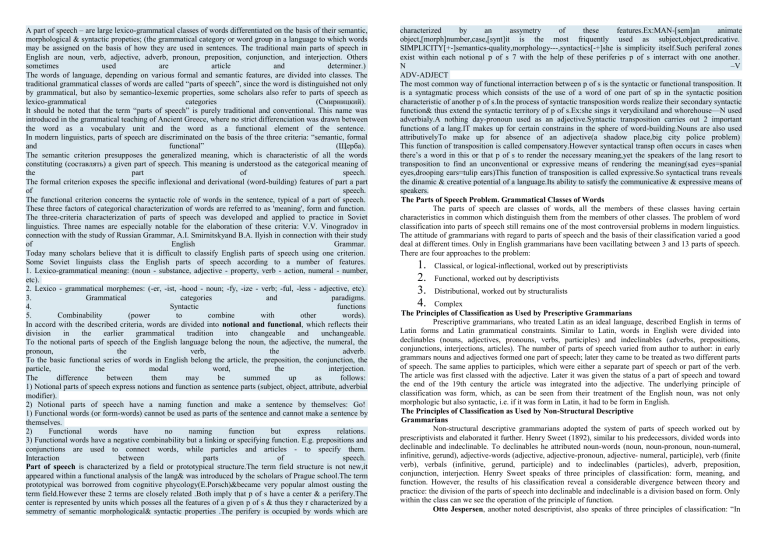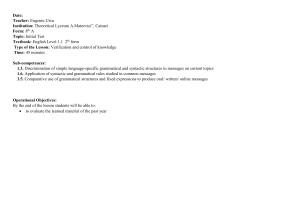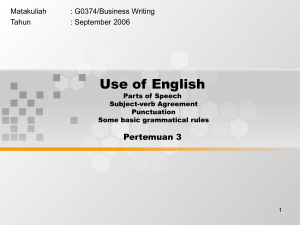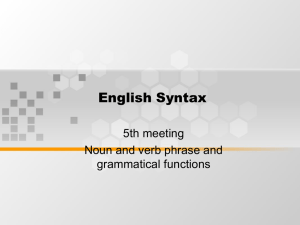Parts of Speech in Linguistics: Classification & Transposition
advertisement

A part of speech – are large lexico-grammatical classes of words differentiated on the basis of their semantic, morphological & syntactic propeties; (the grammatical category or word group in a language to which words may be assigned on the basis of how they are used in sentences. The traditional main parts of speech in English are noun, verb, adjective, adverb, pronoun, preposition, conjunction, and interjection. Others sometimes used are article and determiner.) The words of language, depending on various formal and semantic features, are divided into classes. The traditional grammatical classes of words are called “parts of speech”, since the word is distinguished not only by grammatical, but also by semantico-lexemic properties, some scholars also refer to parts of speech as lexico-grammatical categories (Смирницкий). It should be noted that the term “parts of speech” is purely traditional and conventional. This name was introduced in the grammatical teaching of Ancient Greece, where no strict differenciation was drawn between the word as a vocabulary unit and the word as a functional element of the sentence. In modern linguistics, parts of speech are discriminated on the basis of the three criteria: “semantic, formal and functional” (Щерба). The semantic criterion presupposes the generalized meaning, which is characteristic of all the words constituting (составлять) a given part of speech. This meaning is understood as the categorical meaning of the part of speech. The formal criterion exposes the specific inflexional and derivational (word-building) features of part a part of speech. The functional criterion concerns the syntactic role of words in the sentence, typical of a part of speech. These three factors of categorical characterization of words are referred to as 'meaning', form and function. The three-criteria characterization of parts of speech was developed and applied to practice in Soviet linguistics. Three names are especially notable for the elaboration of these criteria: V.V. Vinogradov in connection with the study of Russian Grammar, A.I. Smirnitskyand B.A. Ilyish in connection with their study of English Grammar. Today many scholars believe that it is difficult to classify English parts of speech using one criterion. Some Soviet linguists class the English parts of speech according to a number of features. 1. Lexico-grammatical meaning: (noun - substance, adjective - property, verb - action, numeral - number, etc). 2. Lexico - grammatical morphemes: (-er, -ist, -hood - noun; -fy, -ize - verb; -ful, -less - adjective, etc). 3. Grammatical categories and paradigms. 4. Syntactic functions 5. Combinability (power to combine with other words). In accord with the described criteria, words are divided into notional and functional, which reflects their division in the earlier grammatical tradition into changeable and unchangeable. To the notional parts of speech of the English language belong the noun, the adjective, the numeral, the pronoun, the verb, the adverb. To the basic functional series of words in English belong the article, the preposition, the conjunction, the particle, the modal word, the interjection. The difference between them may be summed up as follows: 1) Notional parts of speech express notions and function as sentence parts (subject, object, attribute, adverbial modifier). 2) Notional parts of speech have a naming function and make a sentence by themselves: Go! 1) Functional words (or form-words) cannot be used as parts of the sentence and cannot make a sentence by themselves. 2) Functional words have no naming function but express relations. 3) Functional words have a negative combinability but a linking or specifying function. E.g. prepositions and conjunctions are used to connect words, while particles and articles - to specify them. Interaction between parts of speech. Part of speech is characterized by a field or prototypical structure.The term field structure is not new,it appeared within a functional analysis of the lang& was introduced by the scholars of Prague school.The term prototypical was borrowed from cognitive phycology(E.Porsch)&became very popular almost ousting the term field.However these 2 terms are closely related .Both imply that p of s have a center & a perifery.The center is represented by units which posses all the features of a given p of s & thus they r characterized by a semmetry of semantic morphological& syntactic properties .The perifery is occupied by words which are characterized by an assymetry of these features.Ex:MAN-[sem]an animate object,[morph]number,case,[synt]it is the most friquently used as subject,object,predicative. SIMPLICITY[+-]semantics-quality,morphology---,syntactics[-+]she is simplicity itself.Such periferal zones exist within each notional p of s 7 with the help of these periferies p of s interract with one another. N –V ADV-ADJECT The most common way of functional interraction between p of s is the syntactic or functional transposition. It is a syntagmatic process which consists of the use of a word of one part of sp in the syntactic position characteristic of another p of s.In the process of syntactic transposition words realize their secondary syntactic function& thus extend the syntactic territory of p of s.Ex:she sings it verydixiland and whorehouse—N used adverbialy.A nothing day-pronoun used as an adjective.Syntactic transposition carries out 2 important functions of a lang.IT makes up for certain constrains in the sphere of word-building.Nouns are also used attributivelyTo make up for absence of an adjective(a shadow place,big city police problem) This function of transposition is called compensatory.However syntactical transp often occurs in cases when there’s a word in this or that p of s to render the necessary meaning,yet the speakers of the lang resort to transposition to find an unconventional or expressive means of rendering the meaning(sad eyes=spanial eyes,drooping ears=tulip ears)This function of transposition is called expressive.So syntactical trans reveals the dinamic & creative potential of a language.Its ability to satisfy the communicative & expressive means of speakers. The Parts of Speech Problem. Grammatical Classes of Words The parts of speech are classes of words, all the members of these classes having certain characteristics in common which distinguish them from the members of other classes. The problem of word classification into parts of speech still remains one of the most controversial problems in modern linguistics. The attitude of grammarians with regard to parts of speech and the basis of their classification varied a good deal at different times. Only in English grammarians have been vacillating between 3 and 13 parts of speech. There are four approaches to the problem: 1. 2. 3. 4. Classical, or logical-inflectional, worked out by prescriptivists Functional, worked out by descriptivists Distributional, worked out by structuralists Complex The Principles of Classification as Used by Prescriptive Grammarians Prescriptive grammarians, who treated Latin as an ideal language, described English in terms of Latin forms and Latin grammatical constraints. Similar to Latin, words in English were divided into declinables (nouns, adjectives, pronouns, verbs, participles) and indeclinables (adverbs, prepositions, conjunctions, interjections, articles). The number of parts of speech varied from author to author: in early grammars nouns and adjectives formed one part of speech; later they came to be treated as two different parts of speech. The same applies to participles, which were either a separate part of speech or part of the verb. The article was first classed with the adjective. Later it was given the status of a part of speech and toward the end of the 19th century the article was integrated into the adjective. The underlying principle of classification was form, which, as can be seen from their treatment of the English noun, was not only morphologic but also syntactic, i.e. if it was form in Latin, it had to be form in English. The Principles of Classification as Used by Non-Structural Descriptive Grammarians Non-structural descriptive grammarians adopted the system of parts of speech worked out by prescriptivists and elaborated it further. Henry Sweet (1892), similar to his predecessors, divided words into declinable and indeclinable. To declinables he attributed noun-words (noun, noun-pronoun, noun-numeral, infinitive, gerund), adjective-words (adjective, adjective-pronoun, adjective- numeral, participle), verb (finite verb), verbals (infinitive, gerund, participle) and to indeclinables (particles), adverb, preposition, conjunction, interjection. Henry Sweet speaks of three principles of classification: form, meaning, and function. However, the results of his classification reveal a considerable divergence between theory and practice: the division of the parts of speech into declinable and indeclinable is a division based on form. Only within the class can we see the operation of the principle of function. Otto Jespersen, another noted descriptivist, also speaks of three principles of classification: “In my opinion everything should be kept in view, form, function and meaning...” (O Jespersen, 1935:91). On the basis of the three criteria, the scholar distinguishes the following parts of speech: substantives, adjectives, pronouns, verbs, and particles (adverbs, prepositions, conjunctions, interjections). Otto Jespersen’s system is a further elaboration of Henry Sweet’s system. Unlike Henry Sweet, Otto Jespersen separates nouns (which he calls substantives) from noun-words, a class of words distinguished on the basis of function - a noun word is a word that can function as a noun; he also distinguishes pronouns as a separate part of speech, thus isolating them from Henry Sweet’s noun-words and adjective- words. Both scholars treat the verb alike: to Henry Sweet the verb includes primarily finite forms: he doubts as to the inclusion of non-finites in the verb. Although the scholar speaks of form, function and meaning, in practice he gives preference to form. The Principles of Classification as Used by Structural Descriptive Grammarians The traditional classification of words into parts of speech was rejected by structural grammarians who bitterly criticized it from two points. First, in their opinion, traditional grammar relies heavily on the most subjective element in language, meaning. The other is that it uses different criteria of classification: it distinguishes the noun, the verb and the interjection on the basis of meaning; the adjective, the adverb, the pronoun, and the conjunction, on the basis of function, and the preposition, partly on function and partly on form. One of the noted representatives of American structuralism, Charles Fries (1956), rejected the traditional principle of classification of words into parts of speech replacing it with the methods of distributional analysis and substitution. Words that exhibit the same distribution (which is the set of contexts, i.e. immediate linguistic environments, in which a word can appear) belong to the same class. Roughly speaking, the distribution of a word is the position of a word in the sentence. To classify the words of English, Charles Fries used three sentences called substitution frames. He thought that the positions, or the slots, in the sentences were sufficient for the purpose of the classification of all the words of the English language. Frame A The concert was good. Frame B The clerk remembered the tax. Frame C The team went there. The position discussed first is that of the word concert. Words that can substitute for concert (e.g. food, coffee, taste, etc.) are Class 1 words. The same holds good for words that can substitute for clerk, tax and team - these are typical positions of Class 1 words. The next important position is that of was, remembered and went; words that can substitute for them are called Class 2 words. The next position is that of good. Words that can substitute for good are Class 3 words. The last position is that of there; words that can fill this position are called Class 4 words. According to the scholar, these four parts of speech contain about 67 per cent of the total instances of the vocabulary. He also distinguishes 15 groups of function words set up by the same process of substitution but on different patterns. These function words (numbering 154 in all) make up a third of the recorded material. Charles Fries does not use the traditional terminology. To understand his function words better, we shall use, where possible, their traditional names: Group A words (determiners); Group B (modal verbs); Group C (the negative particle “not”); Group D (adverbs of degree); Group E (coordinating conjunctions); Group F (prepositions); Group G (the auxiliary verb “to”); Group H (the introductory “there”); Group I (interrogative pronouns and adverbs); Group J (subordinating conjunctions); Group K (interjections); Group L (the words “yes” and “no”); Group M (the so-called attention-giving signals: look, say, listen); Group N (the word “please”); Group O (the forms “let us”, “lets” in request sentences). It is obvious that in classifying words into word-classes Charles Fries in fact used the principle of function, or combinability (the position of a word in the sentence is the syntactic function of word). Being a structuralist, he would not speak of function: function is meaning while position is not. His classification is not beyond criticism. First, not all relevant positions were tested. Class 3 words are said to be used in the position of good (Frame A). But the most typical position of these words is before Class l words. If this position had been used by the scholar, such words as woolen, wooden, golden, etc. (i.e. relative adjectives) would have found their place in the classification. But if he had done it, the classification would have collapsed, for their position can be filled by other word-classes: nouns, numerals, pronouns. Second, his functional classes are very much ‘splintered’, i.e. broken into small groups. This is good for practice but bad for theory, for theoretical grammar is more interested in uniting linguistic facts than in separating them. Third, being deprived of meaning, his word-classes are “faceless”, i.e. they have no character. No wonder, other structuralists deemed it necessary to return to traditional terminology and to use the criterion of form and, additionally, position. The Classification of Words in Post-Structural Traditional Grammar In modern linguistics, parts of speech are discriminated according to three criteria: semantic, formal and functional. This approach may be defined as complex. The semantic criterion presupposes the grammatical meaning of the whole class of words (general grammatical meaning). The formal criterion reveals paradigmatic properties: relevant grammatical categories, the form of the words, their specific inflectional and derivational features. The functional criterion concerns the syntactic function of words in the sentence and their combinability. Thus, when characterizing any part of speech we are to describe: a) its semantics; b) its morphological features; c) its syntactic peculiarities. The lexemes of a part of speech are united by their meaning. This meaning is a category-forming one. Therefore, it is referred to as categorical meaning. Lexemes that have the meaning of substance or thingness are nouns, those having the meaning of property are adjectives; those having the meaning of process are verbs; those having the meaning of circumstantial property are adverbs. As categorical meaning is derived from lexemes, it is often called lexico-grammatical meaning. In the surface, lexico-grammatical meaning finds outward expression. For instance, the meaning of substance, or thingness, is realized by the following lexico-grammatical morphemes:-er,-ist,-ness,-ship,- ment. It is also realized by specific grammatical forms constituting the grammatical categories of number and case. These outward features are a formal criterion of classification. The functional criterion concerns the syntactic role of a word in the sentence. In accordance with the said criteria, we can classify the words of the English language into notional and functional. To the notional parts of speech belong the noun, the adjective, the numeral, the verb, and the adverb. To the functional parts of speech belong the article, the pronoun, the preposition, the conjunction, the particle, the modal words, and the interjection. The notional parts of speech present open classes while the functional parts of speech present closed classes, i.e. the number of items constituting the notional word-classes is not limited while the number of items constituting the functional word-classes is limited and can be given by the list. The division of language units into notion and function words reveals the interrelation of lexical and grammatical types of meaning. In notional words the lexical meaning is predominant. In function words the grammatical meaning dominates over the lexical one. However, in actual speech the border line between notional and function words is not always clear cut. Some notional words develop the meanings peculiar to function words - e.g. semi-notional words - to turn, to get, etc. Notional words constitute the bulk of the existing word stock while function words constitute a smaller group of words. Although the number of function words is limited (there are only about 50 of them in Modern English), they are the most frequently used units. It will be obvious that the system of English parts of speech as presented here is not the only one possible. All depends on which feature we want to base our classification. So, for instance, if the classifying criterion is the variability of a form, we shall have to unite prepositions, conjunctions, interjections and particles into one class (cf. H. Sweet’s and O. Jespersen’s classifications). If we classify words in accordance with the criterion of meaning, we shall distinguish only four word-classes: nouns, adjectives, verbs and adverbs. Besides, linguists do not agree on the number of features needed to distinguish a part of speech. So, for instance, besides the traditional parts of speech, some linguists distinguish the stative and response words.




